Related Research Articles
In music theory, the term mode or modus is used in a number of distinct senses, depending on context.

Although definitions of music vary wildly throughout the world, every known culture partakes in it, and it is thus considered a cultural universal. The origins of music remain highly contentious; commentators often relate it to the origin of language, with much disagreement surrounding whether music arose before, after or simultaneously with language. Many theories have been proposed by scholars from a wide range of disciplines, though none has achieved broad approval. Most cultures have their own mythical origins concerning the invention of music, generally rooted in their respective mythological, religious or philosophical beliefs.

Kassia, Cassia or Kassiani was a Byzantine-Greek composer, hymnographer and poet. She holds a unique place in Byzantine music as the only known woman whose music appears in the Byzantine liturgy. Approximately fifty of her hymns are extant, most of which are stichera, though at least 26 have uncertain attribution. The authenticity issues are due to many hymns being anonymous, and others ascribed to different authors in different manuscripts. She was an abbess of a convent in the west of Constantinople.

Phthora nenano is the name of one of the two "extra" modes in the Byzantine Octoechos—an eight-mode system, which was proclaimed by a synod of 792. The phthorai nenano and nana were favoured by composers at the Monastery Agios Sabas, near Jerusalem, while hymnographers at the Stoudiou-Monastery obviously preferred the diatonic mele.
Echos is the name in Byzantine music theory for a mode within the eight-mode system (oktoechos), each of them ruling several melody types, and it is used in the melodic and rhythmic composition of Byzantine chant, differentiated according to the chant genre and according to the performance style. It is akin to a Western medieval tonus, an Andalusian tab', an Arab naġam, or a Persian parde.
Oktōēchos is the eight-mode system used for the composition of religious chant in Byzantine, Syriac, Armenian, Georgian, Latin and Slavic churches since the Middle Ages. In a modified form the octoechos is still regarded as the foundation of the tradition of monodic chant in the Byzantine Rite today.
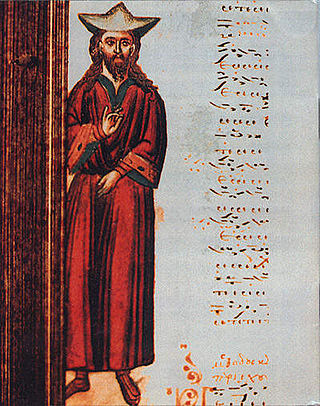
John Koukouzeles Papadopoulos was a Byzantine composer, singer and reformer of Byzantine chant. He was recognized as a saint by the Eastern Orthodox Church after his death. Among the most illustrious musicians of the Palaiologos dynasty, his music remains held in high esteem by Albanians, Bulgarians, Greeks, Macedonians, Romanians and Serbs.
A lampadarius, plural Lampadarii, from the Latin lampada, from Ancient Greek "lampas" λαμπάς (candle), was a slave who carried torches before consuls, emperors and other officials of high dignity both during the later Roman Republic and under the Empire. Lampadarios in the post-Byzantine period designates the leader of the second (left) choir of singers in the Eastern Orthodox church practice.
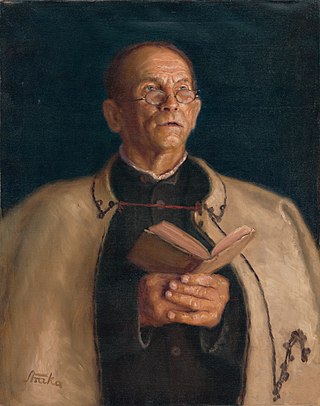
In Christianity, the cantor, female chantress, sometimes called the precentor or the protopsaltes, is the chief singer, and usually instructor, employed at a church, with responsibilities for the choir and the preparation of the Mass or worship service. The term is also used for a similar task in Reform Judaism and in Ancient Egypt.
Miloš Milorad Velimirović was an American musicologist. Twice a recipient of a Fulbright fellowship, he was considered an international expert in the areas of Byzantine music, the history of Slavonic music, and the history of Italian opera in the 18th century.
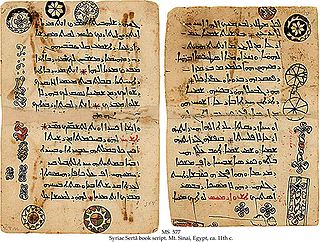
Irmologion is a liturgical book of the Eastern Orthodox Church and those Eastern Catholic Churches which follow the Byzantine Rite. It contains irmoi organised in sequences of odes and such a sequence was called canon. These canons of nine, eight, four or three odes are supposed to be chanted during the morning service (Orthros). The book Irmologion derives from heirmos which means 'link'. The irmos is a melodic model which preceded the composition of the odes. According to the etymology, the book 'collects' the irmoi.
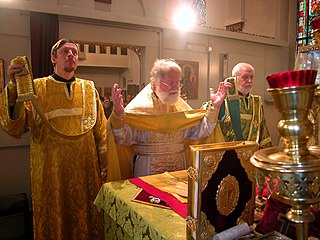
The Cherubikon is the usual Cherubic Hymn sung at the Great Entrance of the Byzantine liturgy.
Manuel Doukas Chrysaphes was the most prominent Byzantine musician of the 15th century.
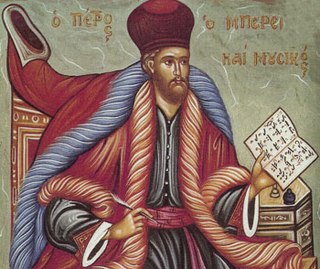
Petros Bereketis or Peter the Sweet was one of the most innovative musicians of 17th-century Constantinople. He, together with Panagiotes the New Chrysaphes, Balasios the Priest and Germanos Bishop of New Patras was one of the most influential figures in the evolution of the Byzantine psaltic art following the fall of Constantinople in 1453, although he never was associated with the Patriarchate in Fener. For many years, he served as the protopsaltis of the parochial church St. Constantine of the Hypsomatheia (Samatya) quarter close to the Marmara coast.
Petros Peloponnesios or Peter the Lampadarios was a cantor, composer and teacher of Byzantine and Ottoman music. He must have served as second domestikos between his arrival about 1764 until the death of Ioannes Trapezountios, and it is assumed that he became lampadarios between 1770 and 1778 at the Great Church of Constantinople, after Daniel the Protopsaltes became Archon Protopsaltes. Large parts of the monodic chant sung in several current traditions of Orthodox Chant are transcriptions of his compositions. He wrote these as a teacher of the "New Music School of the Patriarchate".
Oktōēchos is the name of the eight mode system used for the composition of religious chant in Byzantine, Syriac, Armenian, Georgian, Latin and Slavic churches since the Middle Ages. In a modified form the octoechos is still regarded as the foundation of the tradition of monodic Orthodox chant today.

Oktōēchos is the name of the eight mode system used for the composition of religious chant in Byzantine, Syriac, Armenian, Georgian, Latin and Slavic churches since the Middle Ages. In a modified form the octoechos is still regarded as the foundation of the tradition of monodic Orthodox chant today.
Peter the Byzantine, also known as Petros Byzantios, and "the Fugitive", was a Greek composer and scribe. A pupil of Peter the Peloponnesian, he served the Ecumenical Patriarchate of Constantinople as Domestikos, Lambadarios (1789–1800), and Arch-cantor (1800–1805).
John Laskaris was a Byzantine music theorist and composer.
References
- ↑ Williams 2001.
- ↑ Touliatos-Banker 1984, p. 63.
